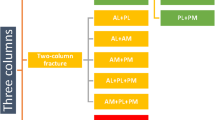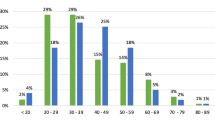Abstract
Background
Proximal tibial buckle fractures are often called “trampoline fractures,” but mechanisms are more varied.
Objective
To assess the frequency of trampoline or bouncer etiology among children with buckle fracture of the proximal tibia, characterizing demographics, alternative etiologies, and fracture patterns.
Materials and methods
We performed retrospective chart review of mechanisms, age and gender of children with radiographs interpreted as proximal tibial buckle fracture between 2010 and 2016. Two pediatric radiologists assessed presence of cortical impaction, cortical break, increased anterior scoop deformity, and oblique extension of fracture toward the physis. We studied the associations among demographics, etiology and fracture appearance using analysis of variance and chi-square/Fisher exact tests.
Results
We identified 145 exams interpreted as proximal tibial buckle fracture (median age 34 months, 64% girls). Bouncing surface was the most common mechanism (44%), and 80% of those cases reported multiple people on the bouncing surface. Falls were the second most common mechanism (30%). Children injured while bouncing were older (median 41 months) than others (median 21 months, P<0.005) and more likely to have oblique extension of fracture toward the physis (P<0.05). Buckle deformity was associated with a younger age (F=8.67; P<0.01), while oblique extension to the physis and concurrent fibula fracture were associated with older age (F=18.62, P<0.001; and F=8.02, P<0.01, respectively).
Conclusion
Trampoline use was the most common single mechanism of injury in children with proximal tibial fracture interpreted as buckle deformity. However, non-bouncing mechanisms were overall more common and occurred in a younger age group at risk for “toddler fractures.”




Similar content being viewed by others
References
Swischuk LE, John SD, Tschoepe EJ (1999) Upper tibial hyperextension fractures in infants: another occult toddler's fracture. Pediatr Radiol 29:6–9
Swischuk LE (2009) Jumped off the trampoline: fell on knee: pain. Pediatr Emerg Care 25:366–367
Boyer RS, Jaffe RB, Nixon GW, Condon VR (1986) Trampoline fracture of the proximal tibia in children. AJR Am J Roentgenol 146:83–85
Kakel R (2012) Concerns: trampoline fracture of the proximal tibia. JBR-BTR 95:332
Klimek PM, Juen D, Stranzinger E et al (2013) Trampoline related injuries in children: risk factors and radiographic findings. World J Pediatr 9:169–174
Gauthe M, Mestas D, Canavese F et al (2014) Differential diagnosis of trampoline fracture from osteomyelitis by bone scan with pinhole collimator. Ann Nucl Med 28:163–166
Arkink EB, van der Plas A, Sneep RW, Reijnierse M (2017) Bilateral trampoline fracture of the proximal tibia in a child. Radiol Case Rep 12:798–800
Dunbar JS, Owen HF, Nogrady MB, McLeese R (1964) Obscure tibial fracture of infants — the toddler's fracture. J Can Assoc Radiol 15:136–144
John SD, Moorthy CS, Swischuk LE (1997) Expanding the concept of the toddler's fracture. Radiographics 17:367–376
Moore BR, Hampers LC, Clark KD (2005) Performance of a decision rule for radiographs of pediatric knee injuries. J Emerg Med 28:257–261
Blumetti FC, Gauthier L, Moroz PJ (2016) The 'trampoline ankle': severe medial malleolar physeal injuries in children and adolescents secondary to multioccupant use of trampolines. J Pediatr Orthop B 25:133–137
Arora V, Kimmel LA, Yu K et al (2016) Trampoline related injuries in adults. Injury 47:192–196
Skak SV, Jensen TT, Poulsen TD (1987) Fracture of the proximal metaphysis of the tibia in children. Injury 18:149–156
Kakel R (2012) Trampoline fracture of the proximal tibial metaphysis in children may not progress into valgus: a report of seven cases and a brief review. Orthop Traumatol Surg Res 98:446–449
Woodward GA, Furnival R, Schunk JE (1992) Trampolines revisited: a review of 114 pediatric recreational trampoline injuries. Pediatrics 89:849–854
Offiah A, van Rijn RR, Perez-Rossello JM, Kleinman PK (2009) Skeletal imaging of child abuse (non-accidental injury). Pediatr Radiol 39:461–470
Tsai A, Coats B, Kleinman PK (2017) Biomechanics of the classic metaphyseal lesion: finite element analysis. Pediatr Radiol 47:1622–1630
Smith GA, Shields BJ (1998) Trampoline-related injuries to children. Arch Pediatr Adolesc Med 152:694–699
Linakis JG, Mello MJ, Machan J et al (2007) Emergency department visits for pediatric trampoline-related injuries: an update. Acad Emerg Med 14:539–544
Choi ES, Hong JH, Sim JA (2018) Distinct features of trampoline-related orthopedic injuries in children aged under 6 years. Injury 49:443–446
Eberl R, Schalamon J, Singer G et al (2009) Trampoline-related injuries in childhood. Eur J Pediatr 168:1171–1174
Loder RT, Schultz W, Sabatino M (2014) Fractures from trampolines: results from a national database, 2002 to 2011. J Pediatr Orthop 34:683–690
Sandler G, Nguyen L, Lam L et al (2011) Trampoline trauma in children: is it preventable? Pediatr Emerg Care 27:1052–1056
Menelaws S, Bogacz AR, Drew T, Paterson BC (2011) Trampoline-related injuries in children: a preliminary biomechanical model of multiple users. Emerg Med J 28:594–598
Hurson C, Browne K, Callender O et al (2007) Pediatric trampoline injuries. J Pediatr Orthop 27:729–732
Briskin S, LaBotz M (2012) Trampoline safety in childhood and adolescence. Pediatrics 130:774–779
Stranzinger E, Leidolt L, Eich G, Klimek PM (2014) The anterior tilt angle of the proximal tibia epiphyseal plate: a significant radiological finding in young children with trampoline fractures. Eur J Radiol 83:1433–1436
Author information
Authors and Affiliations
Corresponding author
Ethics declarations
Conflicts of interest
None
Additional information
Publisher’s note
Springer Nature remains neutral with regard to jurisdictional claims in published maps and institutional affiliations.
Rights and permissions
About this article
Cite this article
Saade-Lemus, S., Nguyen, J.C., Francavilla, M.L. et al. Buckle fracture of the proximal tibia in children and frequency of association with trampoline and inflatable bouncer use. Pediatr Radiol 49, 1327–1334 (2019). https://doi.org/10.1007/s00247-019-04450-0
Received:
Revised:
Accepted:
Published:
Issue Date:
DOI: https://doi.org/10.1007/s00247-019-04450-0




